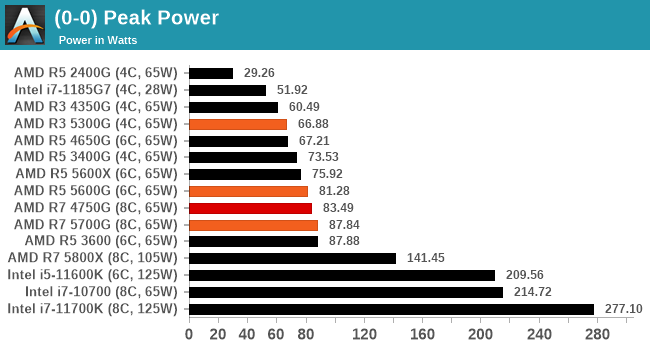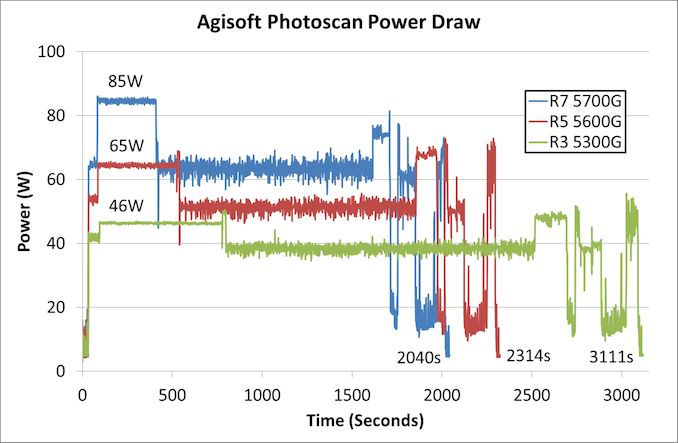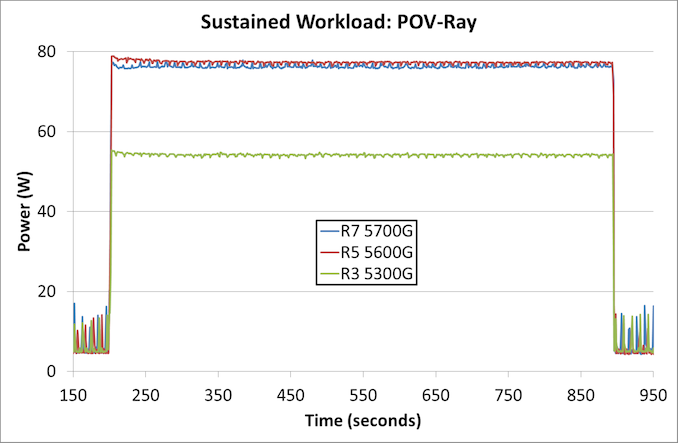The AMD Ryzen 7 5700G, Ryzen 5 5600G, and Ryzen 3 5300G Review
by Dr. Ian Cutress on August 4, 2021 1:45 PM ESTPower Consumption
The nature of reporting processor power consumption has become, in part, a dystopian nightmare. Historically the peak power consumption of a processor, as purchased, is given by its Thermal Design Power (TDP, or PL1). For many markets, such as embedded processors, that value of TDP still signifies the peak power consumption. For the processors we test at AnandTech, either desktop, notebook, or enterprise, this is not always the case.
Modern high-performance processors implement a feature called Turbo. This allows, usually for a limited time, a processor to go beyond its rated frequency. Exactly how far the processor goes depends on a few factors, such as the Turbo Power Limit (PL2), whether the peak frequency is hardcoded, the thermals, and the power delivery. Turbo can sometimes be very aggressive, allowing power values 2.5x above the rated TDP.
AMD and Intel have different definitions for TDP, but are broadly speaking applied the same. The difference comes to turbo modes, turbo limits, turbo budgets, and how the processors manage that power balance. These topics are 10000-12000 word articles in their own right, and we’ve got a few articles worth reading on the topic.
- Why Intel Processors Draw More Power Than Expected: TDP and Turbo Explained
- Talking TDP, Turbo and Overclocking: An Interview with Intel Fellow Guy Therien
- Reaching for Turbo: Aligning Perception with AMD’s Frequency Metrics
- Intel’s TDP Shenanigans Hurts Everyone
In simple terms, processor manufacturers only ever guarantee two values that are tied together - when all cores are running at base frequency, the processor should be running at or below the TDP rating. All turbo modes and power modes above that are not covered by warranty. Intel kind of screwed this up with the Tiger Lake launch in September 2020, by refusing to define a TDP rating for its new processors, instead of going for a range. Obfuscation like this is a frustrating endeavor for press and end-users alike.
However, for our tests in this review, we measure the power consumption of the processor in a variety of different scenarios. These include workflows, real-world image-model construction, and others as appropriate. These tests are done as comparative models. We also note the peak power recorded in any of our tests.
First up is our image-model construction workload, using our Agisoft Photoscan benchmark. This test has a number of different areas that involve single thread, multi-thread, or memory limited algorithms.
For the Ryzen 7 5700G, the most power-hungry part of the test is right at the beginning, where we’re seeing peaks of 85 W. For the 5600G, that first section goes to 65 W, but the peaks actually occur here near the end of the test. The 5300G also has peaks later in the test, but that first section is the lowest, running only at 46 W.
The second test is a sustained rendering workload.
In this instance, the Ryzen 3 5300G is nearer 55 W with a sustained workload over 10 minutes, while the Ryzen 5 and Ryzen 7 sit just below 80 W.
For peak power, we report the highest value observed from any of our benchmark tests.

While all three processors have a TDP rating of 65 W, by default on AMD systems the Package Power Tracking, which is the limiting factor here, is 88 W. The Ryzen 7 is practically at that value, while the Ryzen 5 just goes a smidge over 80 W. The Ryzen 3 on the other hand only matches its TDP in the worst-case scenario.












135 Comments
View All Comments
mode_13h - Thursday, August 5, 2021 - link
Thanks for the correction. That was a real head-scratcher!msroadkill612 - Thursday, August 5, 2021 - link
Under the table on p1"The top part is a Ryzen 7 5700G, featuring eight cores and sixteen threads, with a base frequency of 3.8 GHz and a turbo frequency of 4.6 GHz. The Vega 8 graphics runs at 2000 MHz, and we get 16 lanes of PCIe 3.0 for graphics, plus another four for storage."
Not so -AFAIK - all apus have 8 lanes for the graphics pcie slot.
anand made the same mistake on a previous apu review as i recall. its very misleading.
nanonan - Friday, August 6, 2021 - link
The 4000G series have 16 lanes and so do these, it was not misleading at all as far as I can tell.Fulljack - Friday, August 6, 2021 - link
nope, the connection to GPU were different according to the package. any APUs packaged on AM4 will have x16 PCIe 3.0 connection—always has been since Raven Ridge.for laptop, FP6 and previous package were limited to x8 PCIe 3.0 connection for the GPU.
pman6 - Thursday, August 5, 2021 - link
will have to wait for 6000G, since this has old ass graphics with no AV1 decoding support. Enjoy your choppy 4k/8k videonandnandnand - Thursday, August 5, 2021 - link
~2x graphics performance, AV1 decode, DDR5, PCIe 4.0, USB4, and possibly a Zen 3+ IPC increase.GreenReaper - Thursday, August 5, 2021 - link
Yeah... they're good CPUs, but not the one to get if you're buying something to use for the next decade.GeoffreyA - Thursday, August 5, 2021 - link
Possibly the best for AM4 folk that want an APU.GeoffreyA - Thursday, August 5, 2021 - link
Can't comment on 8K, but 4K runs smoothly even on an old 2200G.pman6 - Thursday, August 5, 2021 - link
not 4k60 AV1 it doesn't. Or it uses a lot of cpu resources